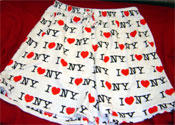TTAB Sustains 2(d) Opposition to "STAR FLY" for Non-Intimate Footwear
You just new from the start of this decision that Albert Trostel and Mucky Duck were going to land hard on Applicant BEE FLY SARL, and that's just what happened. Third-party registrations led the Board to sustain a Section 2(d) refusal to register the mark STAR FLY for "non-intimate footwear, namely, shoes, sport shoes, sandals, boots, ankle boots, moccasins, clogs, loafers, plain pumps and shoes with wedge outsoles; and non-intimate clothing, namely, t-shirts." The Board found the mark likely to cause confusion with the mark STARFLY registered for "intimate apparel, namely, nightshirts, nightcaps, underwear, socks, robes, slippers, boxer shorts, nightcaps, fleece loungers, bras." In re BEE FLY SARL, Serial No. 76365771 (July 25, 2005) [not citable].

Examining Attorney Giancarlo Castro pointed out that the marks are nearly identical and, as to the goods, he submitted six third-party registrations, each covering a number of the clothing and footwear items identified in both the application and the cited registration.
Applicant BEE FLY argued that its goods are non-intimate products, while the goods of the cited registration are intimate apparel (no kidding?); that the trade channels for the respective goods would therefore differ (says who?); that the registered mark is not famous (huh?); and that there is an absence of actual confusion evidence (so what?).
The Board observed that, under In re Albert Trostel & Sons. Co., 29 USPQ2d 1783 (TTAB 1993) and In re Mucky Duck Mustard Co., 6 USPQ2d 1467 (TTAB 1988), third-party registrations have "some probative value to the extent that they may serve to suggest that [the] goods ... are of a type which may emanate from a single source." Moreover, the Board noted that BEE FLY's t-shirts are "closely related to registrant's nightshirts and may be interchangeable in use; and registrant's identification of goods includes footwear items, i.e., slippers." It therefore concluded that confusion is likely.
As to BEE FLY's argument regarding trade channels, the Board asserted that the broad wording of the involved application and the cited registration require it to presume that the goods "are sold through the same channels of trade to the same classes of customers." Applicant's lack-of-fame and lack-of-actual-confusion arguments were deemed irrelevant, the latter particularly so because the application in question was based on intent-to-use, with no evidence of actual use.

TTABlog comment: The Albert Trostel/Mucky Duck line of cases recognizes that third-party registrations "are not evidence that the marks shown therein are in use on a commercial scale or that the public is familiar with them." Nonetheless, the Board accords third-party registrations "some probative value" in showing that goods are related for purposes of supporting a Section 2(d) likelihood of confusion refusal. I suspect that this doctrine was created because Examining Attorneys did not have the ability to gather evidence of actual use of third-party registered marks, and so the TTAB accepted the registrations alone. In this Internet age, however, isn't it now a lot easier for an Examining Attorney to find actual use of a third-party mark? Shouldn't he or she be required to search the Internet to see if a third-party mark is indeed in use? In short, is the Albert Trostel/Mucky Duck doctrine necessary or appropriate any more?
Text Copyright John L. Welch 2005. All Rights Reserved.




0 Comments:
Post a Comment
<< Home